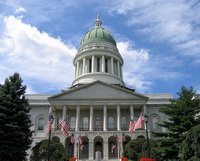Login form
Maine

Where would you go to find rocky cliffs pounded by waves, sandy beaches, snug harbors, old lighthouses, lobster boats, and picturesque fishing villages? For all of these, you would head to Maine.
BIGGEST NEW ENGLAND STATE
Maine is the easternmost state in the United States. It’s one of the six New England states, along with Connecticut, Massachusetts, New Hampshire, Rhode Island, and Vermont. Maine covers nearly as big an area as the other five New England states put together. But Maine doesn’t have many more people than the smallest state, Rhode Island.
|
Facts About Maine |
|
|
|
|
|
Capital |
Augusta |
|
Population |
1,310,000 people |
|
Rank among states in population |
40th |
|
Major cities |
Portland, Lewiston, Bangor |
|
Area |
35,400 square miles |
|
Rank among states in area |
39th |
|
Statehood |
March 15, 1820, the 23rd state |
|
State nickname |
The Pine Tree State |
|
Name for residents |
Mainers |
|
State bird |
Black-Capped Chickadee |
|
State flower |
White Pine Cone and Tassel |
|
State tree |
White Pine |
|
Abbreviation |
ME |
Maine fills up in summer. That’s when tourists arrive. The coast along the Atlantic Ocean is Maine’s biggest tourist attraction. Forested islands lie off the coast. Inland is a rugged wilderness dotted with lakes.
Tourists come to Maine to hike, sail, enjoy the beaches, and eat lobster. They also watch plays at Maine’s summer theaters. Artists come to paint and sketch. There are artist colonies along the coast in Ogunquit, York, and Monhegan Island.
Maine also has mountains. The White Mountains, part of the Appalachians, extend into southern and central Maine. Skiing is popular in winter at Sugarloaf Mountain and other resorts.
LOBSTERS
Maine is world-famous for its lobsters. Many people consider the sweet, white meat of the lobster a delicious food. They dip it in melted butter. Every summer, Rockville, Maine, holds its Lobster Festival. There are many more activities than eating lobster, but the food is the festival’s big treat.
Fishing has been an important activity in Maine since colonial times. Lobster is the most important catch. Fishing boats set out lobster traps with bait inside in the waters along Maine’s coast.
THE PINE TREE STATE
Maine is nicknamed the Pine Tree State. Forests cover 90 percent of the state’s land. No other state is so heavily forested. Many of Maine’s industries have made use of the plentiful timber.
In colonial times, wood from Maine’s forests was sent to England and used for masts and other parts of ships. Maine started its own shipbuilding industry in the 1700s. Until 1900, Maine led the states in producing wooden ships. It made nearly half of the oceangoing vessels in the United States. But shipbuilding grew less important in the state during the 1900s, because steel replaced wood for ships.
Today, most of the trees cut down in Maine are used to make paper. The manufacture of paper and paper products is Maine’s leading industry.
MOUNT DESERT ISLAND
More than 1,300 rocky islands lie off Maine’s coast. Mount Desert Island is the largest and best known. Acadia National Park occupies much of the island. The park combines seacoast and mountains, two features that are rarely found together. It also has lakes for boating and trails for hiking and bicycling.
Bar Harbor is a fancy resort on the island. Many wealthy people built summer homes here in the early 1900s.
INTERNATIONAL PARK
Campobello Island off Maine’s coast has an international park run by Canada and the United States. It’s called the Roosevelt Campobello International Park. The park preserves the home where former United States president Franklin D. Roosevelt spent summer vacations. Roosevelt was vacationing here in 1921 when he developed polio. The disease left him unable to walk without help. But he went on to be elected president four times.
A bridge links the Campobello Island with the Maine mainland. But the island belongs to the Canadian province of New Brunswick.
PUFFIN COLONIES
Maine is as far south as seabirds called puffins nest along North America’s Atlantic Coast. The islands off the coast of Maine once had puffin colonies. But by the early 1900s, only one pair of puffins was left.
Project Puffin began in 1973 to bring the birds back to Maine’s islands. Young puffins were brought in from Canada. Wooden decoy puffins were placed on the islands to attract the young birds. Tape recorders played puffin courtship calls. The effort succeeded. Puffins now breed on several Maine islands. Tour boats take visitors to view the puffin colonies from the water.
EXPLORATION AND SETTLEMENT
English explorer John Cabot may have landed on the Maine coast in 1497. The records aren’t clear. Italian explorer Giovanni da Verrazzano definitely came in 1524. He described the land and its people. Other explorers followed.
Both France and England sent people to settle in Maine. But the first settlements failed because of Maine’s long, cold winters. Later in the 1600s, settlers in Maine lived by fishing, fur trading, and logging.
STATEHOOD
Maine belonged to Massachusetts until 1820. But Maine began to press for independence from Massachusetts soon after the American Revolution ended in 1783. During the War of 1812, it became clear that Massachusetts would not protect settlements in Maine. British ships captured four ports along the coast of Maine in this war.
Maine’s desire for statehood grew stronger after the War of 1812. On March 15, 1820, Maine became the 23rd state. Augusta is the capital of Maine. Portland is the state’s largest city.
Portland grew as a shipbuilding center. It’s still a busy port on the Atlantic Ocean. It’s the northernmost and easternmost port on the Atlantic Coast. Portland is also the U.S. port closest to Europe.
Source: Microsoft ® Encarta

